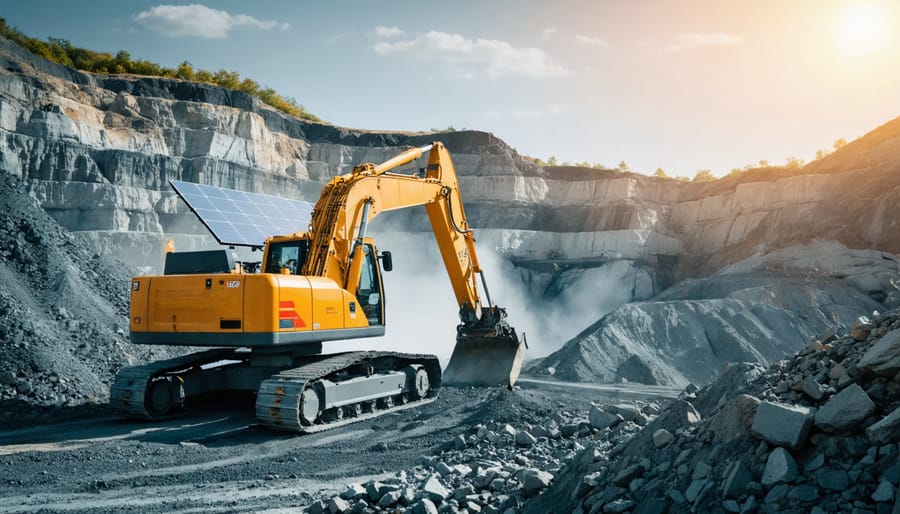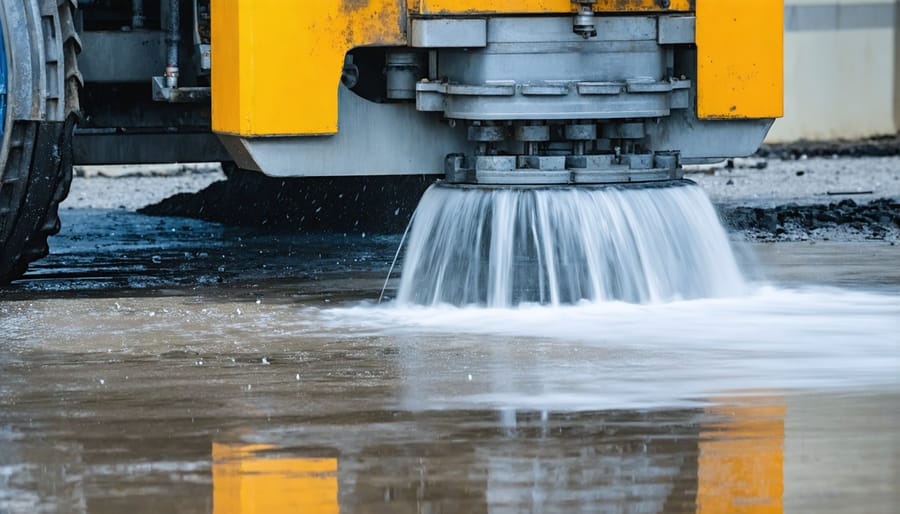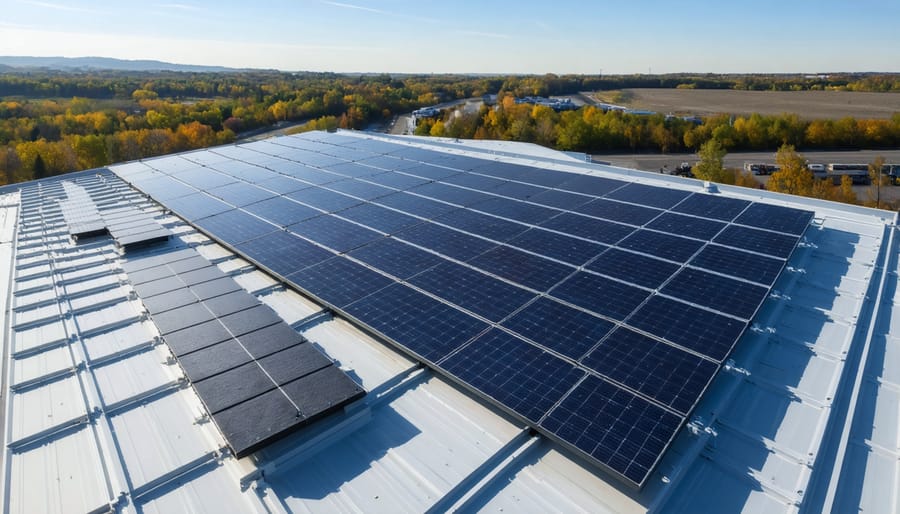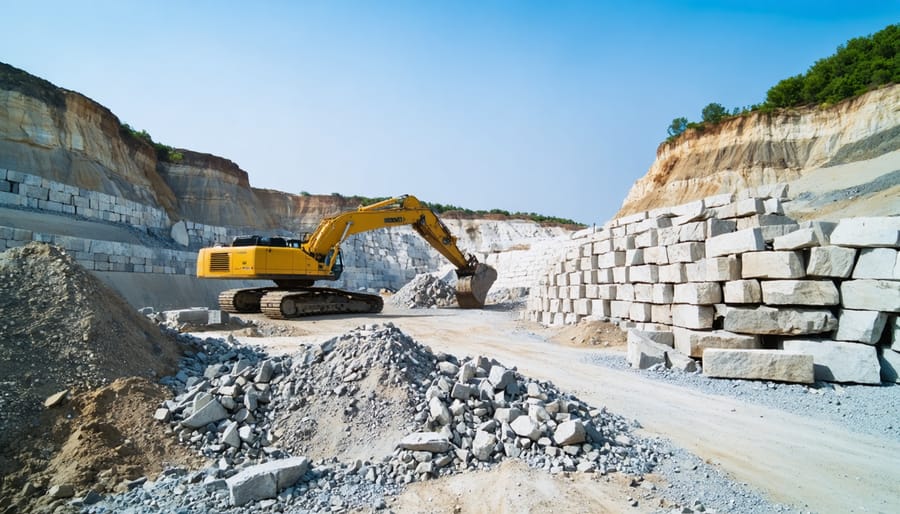Transforming our industrial footprint demands immediate, decisive action as global carbon emissions continue to reshape our climate reality. The path to zero carbon stone production and broader manufacturing sustainability isn’t just an environmental imperative—it’s becoming a competitive necessity in today’s market.
Modern manufacturing faces a critical inflection point where environmental stewardship meets operational efficiency. By implementing advanced energy monitoring systems, optimizing production schedules, and embracing renewable energy solutions, companies can significantly reduce their carbon emissions while improving their bottom line. This transformation requires a comprehensive approach that encompasses everything from raw material sourcing to final product delivery.
The most successful carbon reduction strategies combine technological innovation with practical operational changes. Smart sensors, AI-powered optimization, and renewable energy integration are revolutionizing how industries approach sustainability. These solutions not only decrease environmental impact but also create more resilient and efficient operations that are better positioned for future regulatory requirements and market demands.
Leading manufacturers are already demonstrating that substantial carbon reductions are achievable without compromising product quality or operational efficiency. Their success stories provide a clear roadmap for others to follow, proving that environmental responsibility and business success can go hand in hand.
Current Carbon Footprint Challenges in Stone Production
Extraction Process Emissions
The extraction phase of natural stone production represents a significant source of carbon emissions, primarily due to heavy machinery operations and explosive use in quarrying. Modern quarries typically employ diesel-powered equipment for cutting, drilling, and transportation, contributing to their carbon footprint. However, implementing proven carbon reduction methods can significantly decrease these emissions.
Recent industry studies indicate that optimizing extraction patterns and utilizing electric-powered equipment can reduce emissions by up to 40%. Advanced cutting technologies, such as diamond wire saws and water-jet cutting systems, not only minimize waste but also require less energy compared to traditional methods. Additionally, proper maintenance of equipment and strategic quarry planning help reduce unnecessary machinery operation time.
Leading quarries are now adopting GPS-guided extraction systems and automated cutting processes, which enhance efficiency while reducing fuel consumption. These innovations, combined with regular environmental audits and employee training programs, create a more sustainable extraction process that maintains product quality while minimizing environmental impact.
Processing and Fabrication Impact
The processing and fabrication of natural stone contribute significantly to its overall carbon footprint. Modern cutting and finishing processes require substantial energy consumption, particularly when using traditional diamond-wire saws and polishing equipment. However, recent technological advances have introduced more energy-efficient alternatives, such as water-jet cutting systems and optimized blade technologies that reduce power consumption by up to 30%.
Fabrication facilities can minimize their carbon impact through strategic approaches like implementing heat recovery systems, utilizing renewable energy sources, and optimizing cutting patterns to reduce waste. Computer-aided design (CAD) and automated cutting systems help maximize material yield while minimizing energy usage. Additionally, recycling cutting water and stone slurry can significantly reduce both water consumption and waste disposal impacts.
Many fabricators are now adopting dry-cutting technologies where applicable, which not only reduce water usage but also decrease the energy required for water treatment and recycling. The implementation of variable-speed motors and smart power management systems in fabrication equipment has also proven effective in reducing energy consumption during non-peak operation periods.

Innovative Technology Solutions
Energy-Efficient Machinery
Modern energy-efficient machinery plays a crucial role in reducing the carbon footprint of natural stone production. The latest generation of cutting and processing equipment incorporates advanced features like variable speed drives, automatic shutdown systems, and smart power management, reducing energy consumption by up to 40% compared to older models.
CNC machines with optimized cutting paths minimize waste movement and energy usage while maintaining precision. These machines utilize regenerative braking systems that capture and reuse energy during deceleration, further improving efficiency. Advanced water jet cutting systems now feature high-pressure intensifier pumps that require less electricity while delivering superior performance.
Smart monitoring systems help track energy usage in real-time, allowing operators to identify and address inefficiencies promptly. Many manufacturers are upgrading to LED lighting systems with motion sensors in their production facilities, reducing electricity consumption for illumination by up to 75%.
New dust collection systems incorporate variable frequency drives that adjust power consumption based on actual demand rather than running at full capacity continuously. Similarly, modern air compression systems feature smart controls that optimize pressure levels and reduce idle running time.
Regular maintenance and calibration of equipment ensure optimal performance and energy efficiency. Many manufacturers now offer energy consumption guarantees with their machinery, providing concrete metrics for sustainability planning and carbon reduction goals.

Smart Process Optimization
Modern digital solutions and automation technologies are revolutionizing how natural stone manufacturers optimize their processes while reducing their carbon footprint. Smart sensors and IoT devices monitor energy consumption in real-time, allowing facilities to identify and eliminate inefficiencies throughout the production line. These systems can automatically adjust equipment settings to operate at peak efficiency, reducing unnecessary power usage during idle periods.
Advanced software solutions analyze production data to optimize cutting patterns, minimizing waste material and maximizing yield from each stone block. This not only reduces the environmental impact but also improves resource efficiency. Automated inventory management systems ensure optimal stock levels, preventing overproduction and reducing the energy needed for storage and climate control.
Machine learning algorithms predict maintenance needs before equipment failures occur, preventing energy-wasteful emergency repairs and prolonging machinery lifespan. Smart scheduling systems coordinate production runs to maximize equipment utilization during off-peak energy hours, taking advantage of cleaner grid power and lower rates.
Water recycling systems equipped with smart filters automatically adjust treatment processes based on water quality readings, minimizing both water waste and the energy required for treatment. Climate control systems use predictive analytics to maintain optimal working conditions while reducing HVAC energy consumption.
These digital solutions not only decrease carbon emissions but also provide detailed sustainability reporting, helping manufacturers track their progress and identify further opportunities for improvement.
Sustainable Practices in Transportation
Transportation and logistics in the natural stone industry present significant opportunities for reducing carbon emissions. By implementing strategic changes in shipping methods and route optimization, companies can substantially decrease their carbon footprint while maintaining operational efficiency.
One of the most effective approaches is the adoption of fuel-efficient vehicles and alternative fuel sources. Modern electric and hybrid trucks can reduce emissions by up to 60% compared to traditional diesel vehicles. Companies are increasingly investing in compressed natural gas (CNG) and biodiesel-powered fleets, which offer a cleaner alternative to conventional fossil fuels.
Route optimization software plays a crucial role in minimizing unnecessary travel distances. These advanced systems analyze multiple factors, including delivery schedules, traffic patterns, and load capacity, to determine the most efficient routes. This technology can reduce fuel consumption by 10-15% while improving delivery times.
Local sourcing has emerged as another vital strategy. By prioritizing stone quarries and processors within closer proximity to construction sites, companies can significantly reduce transportation distances. This approach not only decreases emissions but also supports regional economic development and reduces costs.
Consolidation of shipments presents another opportunity for carbon reduction. By combining multiple orders into full truckloads, companies can maximize vehicle capacity and minimize the number of trips required. This practice has shown to reduce carbon emissions by up to 30% compared to multiple partial shipments.
Maintenance practices also contribute to sustainable transportation. Regular vehicle maintenance, proper tire inflation, and aerodynamic modifications can improve fuel efficiency by 5-10%. Additionally, driver training programs focusing on fuel-efficient driving techniques have demonstrated significant reductions in fuel consumption.
Many companies are now implementing real-time tracking systems to monitor fuel consumption and emissions. These systems provide valuable data for identifying areas of improvement and measuring the success of sustainability initiatives. By tracking key performance indicators, organizations can continually refine their transportation strategies for optimal environmental performance.
Renewable Energy Integration
The integration of renewable energy sources into natural stone production facilities represents a significant step toward reducing carbon footprint in the industry. Solar panels installed on facility rooftops and unused land parcels can generate substantial power for cutting and polishing operations, while wind turbines can supplement energy needs in suitable locations.
Many stone production facilities have successfully implemented hybrid energy systems that combine multiple renewable sources. For example, the combination of solar panels and wind turbines can provide more consistent power generation throughout different weather conditions and seasons. Energy storage solutions, such as industrial-scale batteries, help manage power fluctuations and ensure steady operation during non-peak generation periods.
Smart grid technology enables facilities to optimize their renewable energy usage by automatically switching between different power sources based on availability and demand. This integration also allows facilities to feed excess energy back into the local power grid, creating additional revenue streams while supporting community sustainability efforts.
The initial investment in renewable energy infrastructure typically pays for itself within 5-7 years through reduced energy costs. Government incentives and tax benefits for renewable energy adoption can significantly accelerate this return on investment. Moreover, facilities that transition to renewable energy sources often see improved market positioning, as increasingly environmentally conscious customers prefer suppliers with demonstrated sustainability practices.
To maximize the benefits of renewable energy integration, facilities should conduct comprehensive energy audits to identify optimal system sizing and placement. Regular maintenance and monitoring ensure peak system performance and help identify opportunities for further optimization.

Waste Reduction Strategies
Implementing effective waste reduction strategies is crucial for minimizing the environmental impact of natural stone operations. Through efficient resource management, companies can significantly decrease their carbon footprint while improving operational efficiency.
A key approach is implementing closed-loop production systems, where waste materials are recycled back into the manufacturing process. Stone cutting residues can be repurposed for aggregate production, landscaping materials, or even as raw materials for concrete manufacturing. This not only reduces waste but also creates additional revenue streams.
Modern cutting technologies with precise measurements and computer-aided design help minimize material waste during fabrication. Digital templating and nesting software optimize stone slab usage, reducing offcuts and ensuring maximum material utilization. These technologies can reduce waste by up to 30% compared to traditional methods.
Water recycling systems play a vital role in waste reduction. By implementing water treatment and filtration systems, facilities can reuse processing water multiple times, significantly reducing fresh water consumption. The recovered stone particles from water treatment can be repurposed for various applications.
Packaging optimization is another crucial strategy. Using recyclable packaging materials, implementing reusable transport containers, and designing efficient packaging layouts can substantially reduce waste. Some manufacturers have successfully reduced packaging waste by up to 40% through these methods.
Regular maintenance and calibration of equipment ensure optimal performance and reduce material waste from processing errors. Staff training on waste reduction practices and establishing clear waste management protocols are essential for successful implementation of these strategies.
Certification and Compliance
In today’s environmentally conscious market, stone producers are increasingly adopting recognized environmental certifications to validate their sustainability efforts. Leading standards include LEED certification, which awards points for sustainable stone sourcing and production practices, and the Natural Stone Sustainability Standard (ANSI/NSC 373), specifically developed for the stone industry.
The ISO 14001 Environmental Management System certification demonstrates a company’s commitment to minimizing environmental impact through systematic monitoring and improvement. Many producers also pursue carbon neutrality certification, which requires detailed carbon footprint assessment and verified reduction strategies.
Third-party verification bodies regularly audit certified facilities to ensure compliance with strict environmental standards. These assessments evaluate water conservation, energy efficiency, waste management, and transportation optimization. Companies must maintain detailed documentation of their sustainability practices and demonstrate continuous improvement to maintain their certification status.
Regional certifications are also gaining prominence, with European stone producers often pursuing CE marking and eco-labels specific to their markets. These standards ensure compliance with local environmental regulations while promoting sustainable practices across the global stone industry.
For buyers and specifiers, these certifications provide assurance that their stone products meet rigorous environmental standards and contribute to sustainable building goals.
Reducing carbon footprint in natural stone production is not just an environmental imperative but a business necessity in today’s climate-conscious world. The industry has made significant strides through innovative technologies, sustainable practices, and improved efficiency in extraction and processing. By implementing energy-efficient equipment, optimizing transportation routes, and adopting renewable energy sources, manufacturers can substantially decrease their environmental impact while maintaining product quality. Looking ahead, emerging technologies like carbon capture and advanced recycling systems promise even greater reductions in emissions. As consumer demand for sustainable building materials continues to grow, the natural stone industry is well-positioned to meet these expectations while contributing to a more environmentally responsible construction sector. The future of natural stone production lies in balancing traditional craftsmanship with modern, sustainable practices.










